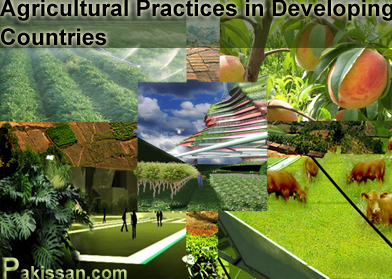Agricultural practices in developing
countries
By Nadia Khawaja
 Why
are small scale farmers wary of change?
Why
are small scale farmers wary of change?
Traditional farming is
characterised by small scale or ‘subsistence farms’ operated
by families who consume most of the output from the farm.
The word “traditional”
means “to do things the way they have usually been done”.
Hence, traditional farming
is mostly prevalent in developing countries with weak
infrastructures and relatively smaller manufacturing and
tertiary sectors.
The average size of the
farm is usually very small, “usually only 1 to 3 hectares”.
For example in Malawi it is only 4 acres hence the output
from farming is very low.
Even if surplus is left from
production it is usually stored for “lean seasons” where
crop yield is low or sold in the local market for minimal
returns. These factors lead to traditional farming being a
risk minimising rather than a profit maximising enterprise.
As capital resources are
limited there is a “low use of purchased inputs other than
labour” and most of the labour force is constituted of the
family itself.
Introducing new technology or
new practices such as mechanisation could thus potentially
increase the risk of farming. Investing in machinery and
cutting down on the labour, for instance, would lead to
local unemployment and in most cases farmers would not have
enough monetary funds available to invest in such
equipments, techniques or collateral to borrow capital.
Mechanisation, such as the
use of tractors, could be irrational since the size of the
holdings is so small that any returns from it will not be
able to match the cost of the equipment. Additionally, the
opportunity cost of labour is fairly low in traditional
farming since farmers are self-employed and workers are not
paid fixed wages.
There would be a need for
guaranteed or instant success for the farmer to adopt a new
technique since loss of production could also mean loss of
nutrition/subsistence for the family.
Even if a new method would
bring in high profits in the long run, any risk of a loss in
the short run would turn the farmer away since it could mean
that the family would have to spend money/capital that is
not at their immediate disposal.
In case of failure, a
sizable proportion of his/her income would be spent on food
which could have previously been generated by the farm.
The crop varieties, power
sources, methods for altering soil fertility and certain
other factors available to traditional farmers constrain
productivity growth. However, many traditional farmers
reduce their risks by practicing mixed farming.
The livestock available can
be used to provide meat, milk and eggs for the family and it
also provides a very low cost means of transportation to the
market for semi-subsistence farms, as traditional substitute
for machinery/technology.
Many traditional irrigation
and harvesting methods also involve the use of livestock.
Mixed cropping is a very important element of mixed farming
which serves the same purpose as the economic practice of
diversification in order to reduce the risk of total loss if
demand for a certain crop falls or climatic conditions do
not permit a favourable harvest.
A combination of crops is
grown and crop rotation is practiced in such a way that
certain crops even serve as soil conditioners. This
minimises the risk posed by natural factors and many farmers
produce crops which are resistant to various weather
conditions.
The demand for labour is
seasonal and there is underemployment causing the marginal
productivity of labour to be low. However, traditional
farmers view farming as a means of subsistence for their
families and often receive their income through other work.
Income from these enterprises
helps offset fluctuations in earnings from agriculture
serving as an effective risk management strategy.
Introducing a new technique could potentially lead to a
misallocation of resources and raise the stakes of risk,
which is an unaffordable cost for traditional farmers.
In traditional farming,
efficiency, as measured by equating marginal returns to
resources in alternative uses, is often high.
Farmers are already aware of
the dangers associated with traditional agriculture, such as
unfavourable climate, and have developed ways to evade those
threats but the introduction of a new risk with a new
technique could produce a double threat.
Undertaking a new a
technique like mechanisation would not only involve
investment of capital but it would also create a need for a
different type of labour that is trained in operating it,
doubling the cost and causing further unemployment.
Short run subsistence or
income is very important to the farmer since small peasant
farms predominate in most developing countries. The income
lost in the transition could make survival for these
families impossible, a risk they would be unwilling to take.
Traditional farmers are economically rational. Their
technique of choice must guarantee a higher yield but at low
cost and low risk factor. Thus they can only undertake a new
technique which does not significantly increase their risk
since profit maximisation might be desired but it is not
their economic goal.
September, 2013
Source:
Pakistan Today